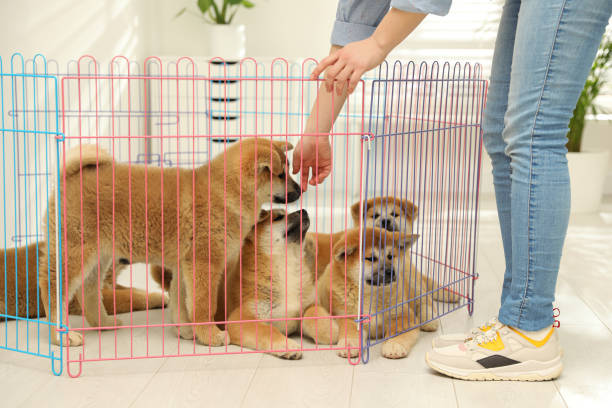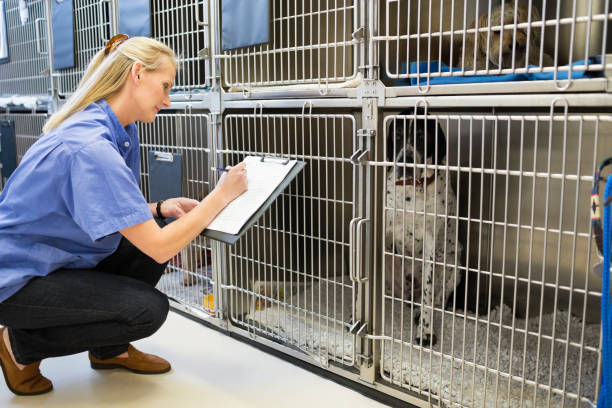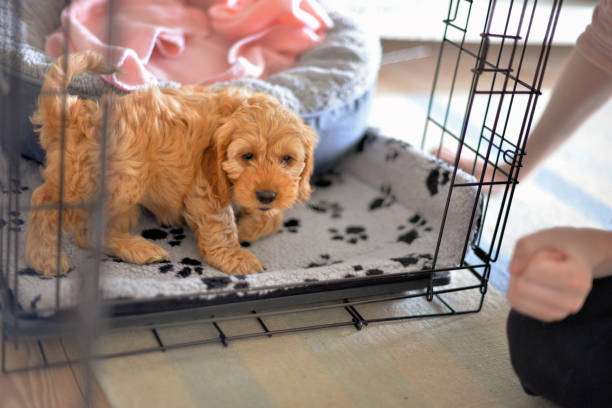Choosing a Dog Crate Size
Crates can help you train your dog and also make a safe haven for them when they need some peace and quiet. However, the wrong size crate will cause anxiety and may even encourage chewing on the sides of the cage.
So take a page from Goldilocks and choose the right crate size for your pup!
Length
A crate is more than just your dog’s den; it becomes a safe place for them to retreat when they feel overwhelmed or nervous. Choosing the right size crate is essential to ensure they are comfortable and happy in their home away from home.
To determine the length of your dog, have them stand on all fours and measure from their nose to the base of their tail (add 2-4 inches for additional space). Most published height measurements are measured to the top of your dog’s head, also known as “withers.” If your dog has naturally erect ears, measure from the tip of their ears.

Once you know their length and height, compare them to crate size charts. Remember, a crate should be big enough for your dog to stand up and move comfortably but not so large that it encourages play or hinders successful house training.
Puppies need smaller crates than adult dogs, but some manufacturers make crates that “grow” with your puppy by offering dividers that you can add or remove to adjust the interior space as they grow. If you plan to use a crate for car travel, consider the dimensions of your vehicle’s opening as well. Most cars can only fit a large 36″ crate and smaller, so make sure you check before purchasing.
Height
You wouldn’t like to sleep in a small bed that you had trouble stretching out in, and neither would your dog. Your pet deserves a crate that’s large enough to sit in and stretch out in without having its head lowered. It should also be spacious enough to allow it to lie down comfortably.
Measure your dog while it’s sitting, from the base of one of its front paws to the top of its head (or its shoulders, if it has erect ears). Add four inches to this measurement to account for wiggle room and comfort.

Once you have your pet’s height, determine its weight to ensure that the crate is not too heavy for you to lift. It’s always best to weigh your dog on a scale that you know will be accurate, rather than estimate its weight by body mass index or breed recommendations alone.
If you’re buying a crate for an adult dog, consider whether or not it will grow into its adult size. Some crates feature divider panels that you can adjust to expand the space inside as your puppy grows. This is a great option for puppies, as they require smaller spaces than full-grown dogs but will need more room as they grow into adulthood. Otherwise, you may want to opt for a crate that’s already the appropriate size for your adult dog.
Width
The width of the crate should be big enough for your dog to stand up and turn around comfortably with the door closed. It should also be large enough for the pet to lie down or stretch out if they want to do so. Having an uncomfortable or cramped feel to the crate can make your dog dislike it or even resist spending time in there, so it’s important that they have plenty of room.

You can use a measuring tape to get the measurements for your dog’s height, length and width. For the length, measure from their nose to the base of their tail and add 2-4 inches (this will ensure that there’s enough room in the crate for them). For the height, measure from the ground up to the highest point of their head or ears (whichever is higher). Then, for the width, use a ruler to get your dog’s widest measurement.
When choosing a crate for your dog, be sure to consider any other items you plan on putting inside of it, including food and water bowls, toys and bedding. It’s also important to remember that dogs can jump and move about quite a bit, so the crate should be large enough for the animal to fit comfortably inside while still being able to move around.
Depth
Crates provide a safe place for dogs to stay when you are not home. They also help with potty training and other aspects of dog training. The best crates are well-sized, providing enough room for your dog to lie down comfortably and stretch out. If the crate is too small, your dog may be cramped and uncomfortable. It is also possible for your dog to escape the crate if it is too small.
When choosing a dog crate size, it is important to measure your pet while they are in a sitting position. This allows you to determine their height and length measurements. You should add 2 to 4 inches to both of these numbers to find the ideal crate size for your pet.
If your dog is a puppy, you may want to consider purchasing a crate that is slightly larger than their estimated adult size. This will give them some room to grow into the crate and prevent them from becoming frustrated or having accidents inside their crate.

